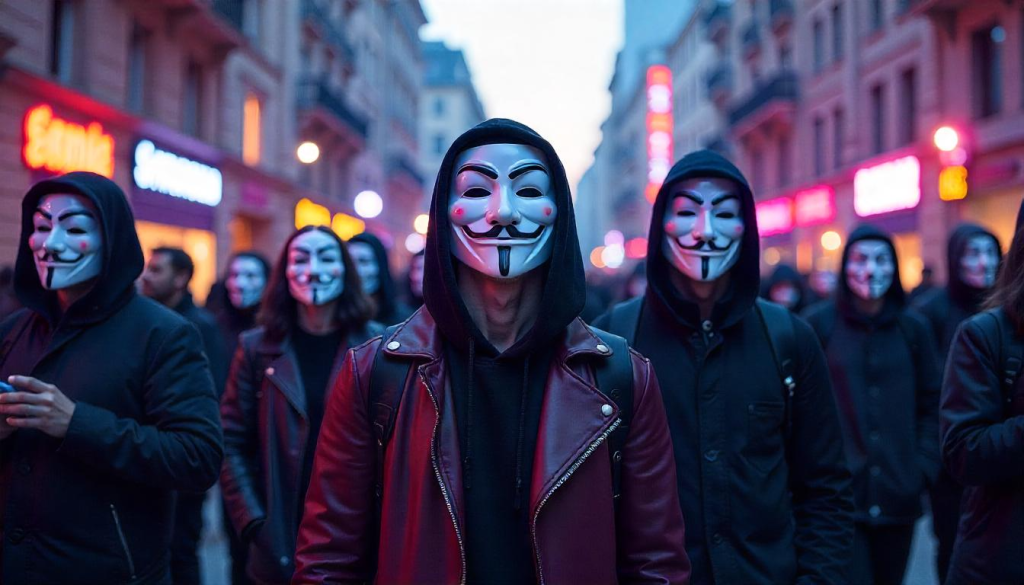The global collective known as Anonymous has intrigued the world for years with its digital protests, cyberattacks, and mysterious nature. Unlike traditional organizations, it has no official leader, office, or membership list. Yet, it consistently manages to coordinate complex actions and campaigns. So, how do they stay organized? The answer lies in how they communicate—discreetly, efficiently, and anonymously.

Understanding the Decentralized Model
Anonymous doesn’t work like a business or government agency. Instead, it follows a decentralized, open-participation model. Anyone who believes in its ideals—freedom of information, anti-censorship, and social justice—can align with the group. There’s no formal registration or approval process. This makes communication critically important, as coordination must happen without centralized oversight.
Where the Conversation Begins: Anonymous Gathering Spots
1. Imageboards and Forums
Anonymous initially gained traction on sites like 4chan, especially on boards like “/b/” where anonymity is the norm. These forums allowed users to discuss plans, pitch ideas, or even launch protest movements—all without revealing personal details. Over time, other platforms like Reddit, Pastebin, and even GitHub Gists became spaces for posting manifestos or sharing technical information. However, due to monitoring and shutdown risks, these are mostly used for temporary communication.
2. IRC (Internet Relay Chat)
Though it may seem outdated, IRC remains a favorite tool for Anonymous. These chat rooms provide real-time messaging and can be secured with passwords or encryption. Since IRC servers can be self-hosted or hidden behind proxy networks, they offer a layer of privacy. Private IRC channels are often created for specific operations, with access granted only to trusted participants. This system helps ensure security while allowing live collaboration.
3. Encrypted Chat Apps
In recent years, many Anonymous participants have switched to encrypted communication apps like Signal, Session, Matrix (Element), and Tox. These platforms provide end-to-end encryption, meaning conversations cannot be read by third parties—even the app developers themselves. Apps like Telegram are sometimes used for wider broadcast due to their channel features, though they are not as secure as peer-to-peer or decentralized options.
Anonymous & Anonymity: Tools That Keep Them Hidden
1. The Tor Network
One of the most widely-used tools in Anonymous circles is Tor (The Onion Router). This free, open-source software anonymizes internet activity by routing traffic through several volunteer nodes. It’s essential for accessing .onion sites on the dark web, where many Anonymous communication hubs are located. Through Tor, members can visit hidden forums or drop secure messages without risking exposure. This layer of anonymity is vital to avoid surveillance or legal consequences.
2. VPNs and Proxy Chains
In addition to Tor, many users rely on Virtual Private Networks (VPNs) or proxy chains. These tools help mask a user’s real IP address and can create complex routing paths that are difficult to trace. Some hardcore users even daisy-chain multiple VPNs and proxies, adding further layers of anonymity while communicating or launching actions.
How They Collaborate on Operations
Once an idea gains traction—say, a protest against a government or a company—Anonymous members begin coordinating. They may use collaborative editing platforms like Etherpad, CryptPad, or private wikis to write plans or statements. These tools allow real-time editing by multiple anonymous users. Members with technical expertise often share scripts, tutorials, or data dumps using platforms like AnonFiles or Mega, typically through one-time-use or expiring links to reduce traceability.
Spreading the Word: Public Messaging and Recruitment
Anonymous is well-known for its public-facing videos, usually featuring a robotic voice, a digital background, and the iconic Guy Fawkes mask. These videos serve as press releases—announcing operations, expressing solidarity, or warning targets. YouTube, Vimeo, and even Twitter are commonly used for releasing such content. The group also uses hashtags like #OpISIS or #OpRussia to build momentum and allow others to follow the cause. This hashtag strategy serves as both a rallying cry and an informal way to organize content under specific campaigns.
Flexibility and Adaptation
Over time, Anonymous has had to evolve its methods. Increased surveillance and stricter regulations on major platforms have forced the group to constantly adapt. Old communication tools are replaced with newer, more secure ones. Forums disappear and reappear under different names. If one method is compromised, another takes its place. The lack of central leadership is a weakness in some ways—it can lead to disorganization or confusion. But it also ensures resilience. No single point of failure means the movement can survive censorship, shutdowns, or arrests.
Trust and Vetting
While anyone can claim to be part of Anonymous, trusted circles often form within the group. Regular contributors and technically skilled members gain respect over time. Access to inner discussions or sensitive operations is typically restricted to those who’ve proven their commitment and security awareness. Some operations are fully public, while others are kept “low noise” to avoid tipping off adversaries. Either way, communication always follows a rule: trust no one completely.
Final Thoughts
Anonymous may not have a leader, but it has a strong internal communication system built around anonymity, real-time collaboration, and constant reinvention. Whether through encrypted messaging apps, hidden forums, or the Tor network, its members manage to stay in touch, plan operations, and execute global protests—all while remaining invisible. This complex, ever-shifting system of communication is one of the reasons Anonymous continues to thrive in the digital world. It’s proof that with the right tools and a shared cause, even the most decentralized group can create global impact.